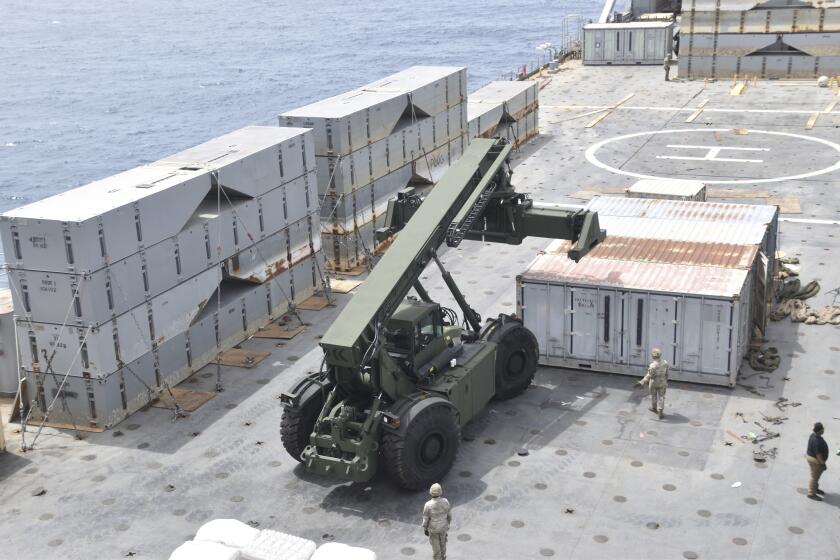Locomotive Industry Again Building Steam
In a far corner of Building 10, past the embryos of Amtrak locomotives, General Electric technicians tear up a battered old red locomotive, and two visiting engineers take notes in Russian.
Akhmet Balymov and Danetay Akhmetov of Kazakhstan have a big job. After GE strips the locomotive down to a shell and rebuilds it, the two engineers will take it and repair kits for 30 other locomotives back to their Central Asian nation. There, they will begin reviving a rundown fleet.
“They think for the economy, it’s a major thing to put the railways in the right position,” said Alexandr Grigoryan, a GE employee who translated for the Kazakhs.
Kazakhstan’s interest in the work at the GE Transportation Systems plant is a sign of the growing worldwide demand for locomotives.
And GE is in a good position to take advantage of that demand.
It has dominated the market for the past five years, supplanting General Motors, its only competitor for the U.S. locomotive market, as the leader. It has reduced manufacturing time per locomotive from 90 days to 26.
Anthony Hatch, transportation analyst for NatWest Securities Inc. in New York, said the big five railroads--Conrail, Union Pacific Corp., Norfolk Southern Railroad, CSX Corp. and Burlington Northern Santa Fe--all are buying locomotives as part of a drive to win business away from the trucking industry.
Outside of the United States--particularly in South Africa, South America and Southeast Asia--the increase in demand follows a trend to turn railroads over to private companies.
“The railroad industry is percolating worldwide,” Hatch said.
That fact isn’t lost on Dave Calhoun, president of GE Transportation Systems, who has a two-pronged plan to protect his company against downturns in the U.S. market. One approach is to make new locomotives for developing nations; the other is to service existing locomotives--of all makes--to extend their 20-year lives.
GE’s Kazakhstan project illustrates both approaches.
Industrywide, a new locomotive costs $1.5 million and up, but a remanufacture--replacing the machine’s high-tech components--costs about $800,000 and can prolong an old locomotive’s life by 15 years. A $300,000 overhaul, a smaller project, can lengthen it by seven years.
To save even more money, the Kazakhs sent to Erie only one old locomotive, which GE will transform into a prototype and send back with the remanufacture kits.
In Kazakhstan alone--the largest former Soviet republic after Russia--several hundred rusty locomotives need new life. In all, the former Soviet republics have thousands.
“That’s a huge potential market for us,” GE Transportation spokeswoman Susan Breon said.
GE’s market dominance is relatively new. From the 1950s to the 1980s, General Motors dominated.
“GE was an also-ran,” said Charles M. Vincent, a railroad industry analyst for PNC Asset Management Group in Philadelphia. “It was commonly regarded that GE produced inferior locomotives.”
During the 1980s, GE improved its locomotive technology and customer relations. Last year, it made 740 high-power freight locomotives in its Erie assembly plant, nearly two-thirds of the nation’s demand. General Motors made the other 420.
Both GM and GE have developed alternating-current locomotives. Until about 1993, all locomotives were on direct current. Alternating current has fewer mechanical parts to break down and provides superior traction, so fewer locomotives are needed to pull a load.
European and Japanese companies don’t compete in the U.S. locomotive market, probably because more muscular machines are needed in the United States--those coal trains get heavy.
And GM and GE locomotives don’t sell well in Europe, which tends to buy locomotives made by companies that employ Europeans.
Mike Iden, director of technical services for Union Pacific Railroad in Omaha, Neb., said GM and GE both make good locomotives. But he added that GE has a manufacturing capacity that is lacking at General Motors, which has moved its locomotive assembly operation to London, Ontario.
Rich Fleming, spokesman for General Motors’ Electro-Motive Division in LaGrange, Ill., near Chicago, where GM still manufactures locomotive components, said capacity isn’t a problem.
“We have the means to manufacture as many locomotives as we get orders for,” Fleming said. He wasn’t specific about why GM wasn’t landing more orders.
Recently, Conrail bought GM parts for at least 25 locomotives that were assembled by Conrail employees in Altoona. Fleming said the arrangement benefited both companies--GM by freeing production flexibility and Conrail by keeping workers employed.
Hatch, the NatWest analyst, said GM’s Electro-Motive lost its competitive spirit, but warned against counting GM out.
GM announced in June that it is negotiating with Siemens AG of Berlin to combine their locomotive businesses. Analysts said Siemens’ technological expertise could help GM compete in the domestic market.
GE also has an association with a Berlin-based company, ABB Daimler Benz. By the end of the year, they plan to have a prototype of a lightweight locomotive that uses the new alternating-current technology.
(BEGIN TEXT OF INFOBOX / INFOGRAPHIC)
Made in the U.S.A.
Freight locomotives purchased new or rebuilt in the United States; the numbers include deliveries only:
*--*
Year New Rebuilt 1955 1,097 22 1960 389 61 1965 1,387 16 1970 1,029 64 1975 772 38 1980 1,480 189 1986 280 128 1987 131 110 1988 356 80 1989 609 138 1990 530 176 1991 472 131 1992 323 142 1993 504 217 1994 821 395 1995 928 201
*--*
Source: Assn. of American Railroads
More to Read
Start your day right
Sign up for Essential California for news, features and recommendations from the L.A. Times and beyond in your inbox six days a week.
You may occasionally receive promotional content from the Los Angeles Times.






